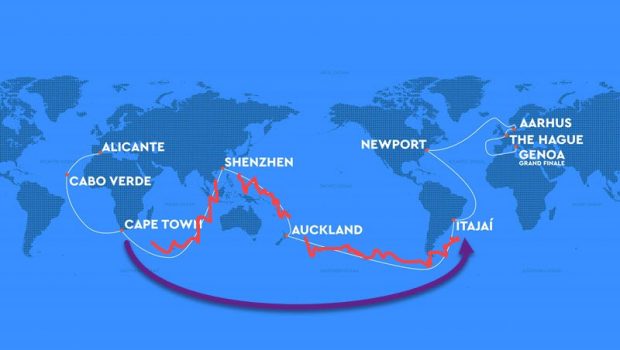Revised course for The Ocean Race
Published on November 4th, 2021
The race course for the 14th edition of The Ocean Race around the world has been updated due to continuing complications involving the pandemic, which has removed legs stopping in China and New Zealand.
As a result, this is the longest lower latitude leg in the 50 year history of the event – 12,750 nautical mile marathon between Cape Town, South Africa to Itajaí, Brazil. This change will also delay the start from Alicante, Spain, originally planned for October 2022, to now late December 2022 or early January 2023 with the final date yet to be announced.
The rest of the course remains unchanged from what was confirmed March 2020 and then delayed one year due to the pandemic.
The race starts with the IMOCA and VO65 fleets heading out of the Mediterranean Sea to Cabo Verde, visiting this African island nation for the very first time, before racing down to a perennial favorite among stopovers in Cape Town, South Africa.
But from there, it is a return to the roots of the race with a massive sojourn across the southern oceans, over 30 days of racing to transit the three great Capes – the Cape of Good Hope, Cape Leeuwin and Cape Horn, arriving in Itajaí, Brazil, host of the past three stopovers in South America.
“The ongoing and unpredictable effects of COVID have meant it is impossible, at this time, to do the planning necessary to ensure successful stops in China and New Zealand,” explained Johan Salén, the Managing Director of The Ocean Race.
“China and New Zealand remain important to the present and the future of The Ocean Race, and we plan to return to both countries again,” said Race Chairman Richard Brisius. “We will work diligently with both to explore ways for them to have a meaningful presence in this edition as well.
The previous plan had the course going from Cape Town to Shenzhen, China, with the following leg from Shenzhen to Auckland, New Zealand before going to Itajaí. Now the fleet tackles the longest leg ever in race history.
From Itajaí, the race course heads north to Newport, Rhode Island, USA, before crossing the Atlantic to northern European stops in Aarhus, Denmark and The Hague in The Netherlands, before the Grand Finale finish in the Mediterranean in Genova, Italy.
“This update to the race route makes it reminiscent of the original Ocean Race’s of the past, and I hope the delay of the start until after the Route du Rhum will entice more teams to join us on the start line,” said Charlie Enright, skipper of 11th Hour Racing Team.
“Not only is it a simpler race from a logistics and organization point of view, it should also be more cost-effective and more accessible for other IMOCA teams, particularly those looking to build-up to the 2024 Vendée Globe.”
For IMOCA sailors, which focus every four years on the non-stop round the world Vendée Globe, they remain prepared for the revised course.
“When I look at The Ocean Race, I see a great opportunity,” said Paul Meilhat, winner of the Route du Rhum in 2018. “This is a race that will push us to the limits as sailors but is also set up well for us as IMOCA sailors to race in a fully-crewed format, and showcase the fastest, foiling, offshore race boats to fans of the sport all around the world.”
Chris Nicholson, a six-time race veteran who is currently putting together a campaign with W-Ocean Racing, approves of the change.
“This race now combines the ideal race for the sailors whilst still delivering for the stakeholders,” notes Nicholson. “One of the best parts of competing in The Ocean Race is being able to push yourself and your boat to the limit, now we have been given a taller mountain to climb and I cannot wait for the challenge.”
Stopover dates will be announced shortly as the route logistics are fully confirmed. Entries for the race will be announced by participating teams over the coming months – the list of registered teams can be found below.
“This race course, for sailors and teams in both the IMOCA and VO65 classes, is shaping up to provide one of the toughest challenges in the long story of the Race,” Salén concluded. “Over our 50 years of history, The Ocean Race has evolved with the times, but remained true to its core values. We’re looking forward to the next start in Alicante in December/January to write the next chapter.”
The Ocean Race (formerly Volvo Ocean Race) will be raced in two classes of boats: the high-performance, foiling, IMOCA 60 class and the one-design VO65 class which has been used for the last two editions of the race. Entries in the IMOCA 60 class will compete for The Ocean Race trophy, while those racing the VO65s will chase the Ocean Challenge Trophy. The 14th edition was originally planned for 2021-22 but was postponed one year due to the pandemic.
Race details – Route – Teams – Facebook
Source: The Ocean Race









 We’ll keep your information safe.
We’ll keep your information safe.